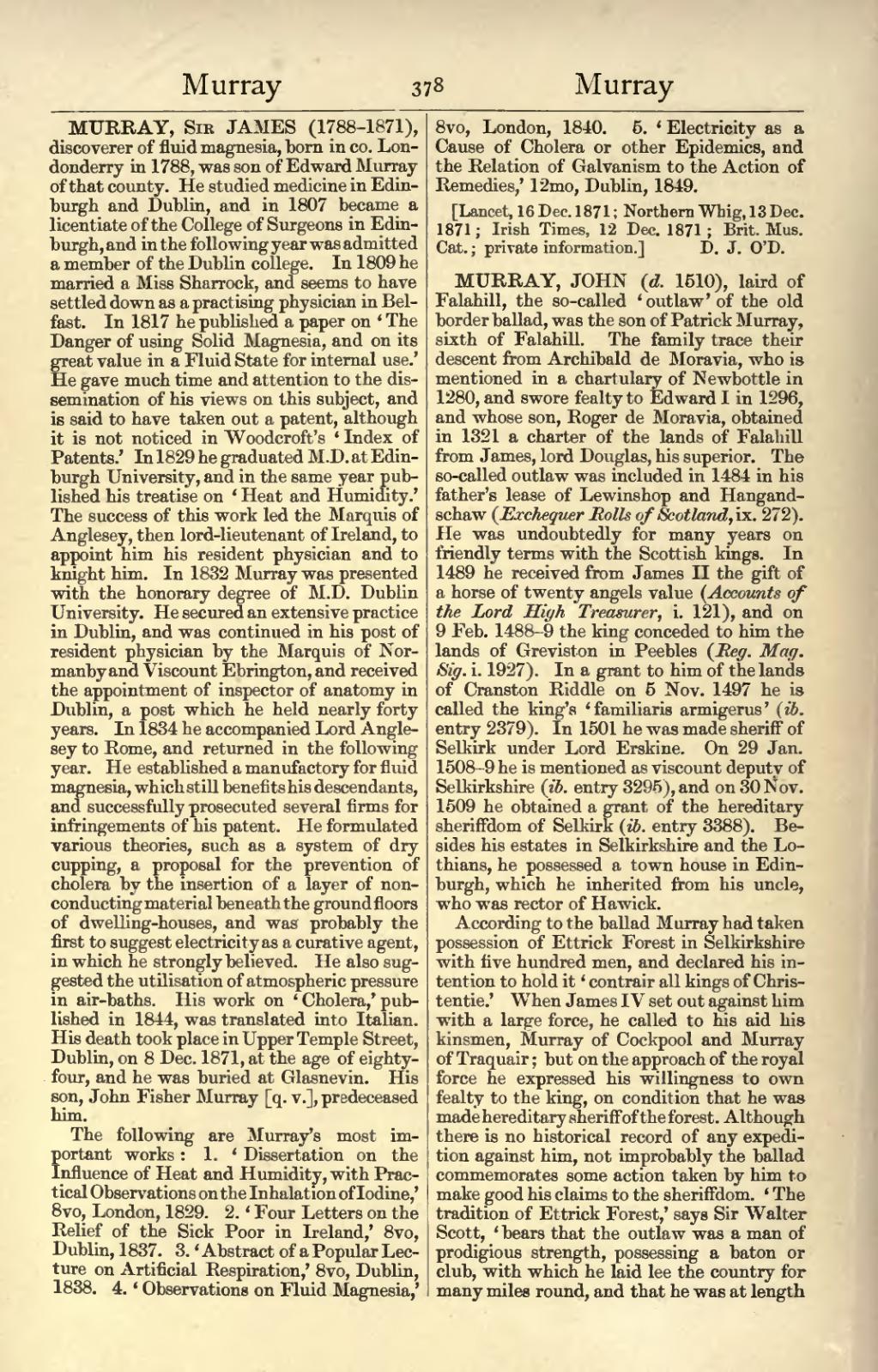MURRAY, Sir JAMES (1788–1871), discoverer of fluid magnesia, born in co. Londonderry in 1788, was son of Edward Murray of that county. He studied medicine in Edinburgh and Dublin, and in 1807 became a licentiate of the College of Surgeons in Edinburgh, and in the following year was admitted a member of the Dublin college. In 1809 he married a Miss Sharrock, and seems to have settled down as a practising physician in Belfast. In 1817 he published a paper on 'The Danger of using Solid Magnesia, and on its great value in a Fluid State for internal use.' He gave much time and attention to the dissemination of his views on this subject, and is said to have taken out a patent, although it is not noticed in Woodcroft's 'Index of Patents.' In 1829 he graduated M.D. at Edinburgh University, and in the same year published his treatise on 'Heat and Humidity.' The success of this work led the Marquis of Anglesey, then lord-lieutenant of Ireland, to appoint him his resident physician and to knight him. In 1832 Murray was presented with the honorary degree of M.D. Dublin University. He secured an extensive practice in Dublin, and was continued in his post of resident physician by the Marquis of Normanby and Viscount Ebrington, and received the appointment of inspector of anatomy in Dublin, a post which he held nearly forty years. In 1834 he accompanied Lord Anglesey to Rome, and returned in the following year. He established a manufactory for fluid magnesia, which still benefits his descendants, and successfully prosecuted several firms for infringements of his patent. He formulated various theories, such as a system of dry cupping, a proposal for the prevention of cholera by the insertion of a layer of non-conducting material beneath the ground floors of dwelling-houses, and was probably the first to suggest electricity as a curative agent, in which he strongly believed. He also suggested the utilisation of atmospheric pressure in air-baths. His work on ' Cholera,' published in 1844, was translated into Italian. His death took place in Upper Temple Street, Dublin, on 8 Dec. 1871, at the age of eighty-four, and he was buried at Glasnevin. His son, John Fisher Murray [q. v.], predeceased him.
The following are Murray's most important works : 1. 'Dissertation on the Influence of Heat and Humidity, with Practical Observations on the Inhalation of Iodine,' 8vo, London, 1829. 2. 'Four Letters on the Relief of the Sick Poor in Ireland,' 8vo, Dublin, 1837. 3. 'Abstract of a Popular Lecture on Artificial Respiration,' 8vo, Dublin, 1838. 4. 'Observations on Fluid Magnesia,' 8vo, London, 1840. 5. 'Electricity as a Cause of Cholera or other Epidemics, and the Relation of Galvanism to the Action of Remedies,' 12mo, Dublin, 1849.
[Lancet, 16 Dec. 1871; Northern Whig, 13 Dec. 1871; Irish Times, 12 Dec. 1871; Brit. Mus. Cat.; private information.]
MURRAY, JOHN (d. 1510), laird of Falahill, the so-called 'out law' of the old border ballad, was the son of Patrick Murray, sixth of Falahill. The family trace their descent from Archibald de Moravia, who is mentioned in a chartulary of Newbottle in 1280, and swore fealty to Edward I in 1296, and whose son, Roger de Moravia, obtained in 1321 a charter of the lands of Falahill from James, lord Douglas, his superior. The so-called outlaw was included in 1484 in his father's lease of Lewinshop and Hangandschaw (Exchequer Rolls of Scotland, ix. 272). He was undoubtedly for many years on friendly terms with the Scottish kings. In 1489 he received from James II the gift of a horse of twenty angels value (Accounts of the Lord High Treasurer, i. 121), and on 9 Feb. 1488-9 the king conceded to him the lands of Greviston in Peebles (Reg. May. Sig. i. 1927). In a grant to him of the lands of Cranston Riddle on 5 Nov. 1497 he is called the king's 'familiaris armigerus' (ib. entry 2379). In 1501 he was made sheriff of Selkirk under Lord Erskine. On 29 Jan. 1508-9 he is mentioned as viscount deputy of Selkirkshire (ib. entry 3295), and on 30 Nov. 1509 he obtained a grant of the hereditary sheriffdom of Selkirk (ib. entry 3388). Besides his estates in Selkirkshire and the Lothians, he possessed a town house in Edinburgh, which he inherited from his uncle, who was rector of Hawick.
According to the ballad Murray had taken possession of Ettrick Forest in Selkirkshire with five hundred men, and declared his intention to hold it 'contrair all kings of Christentie.' When James IV set out against him with a large force, he called to his aid his kinsmen, Murray of Cockpool and Murray of Traquair; but on the approach of the royal force he expressed his willingness to own fealty to the king, on condition that he was made hereditary sheriff of the forest. Although there is no historical record of any expedition against him, not improbably the ballad commemorates some action taken by him to make good his claims to the sheriffdom. 'The tradition of Ettrick Forest,' says Sir Walter Scott, 'bears that the outlaw was a man of prodigious strength, possessing a baton or club, with which he laid lee the country for many miles round, and that he was at length
